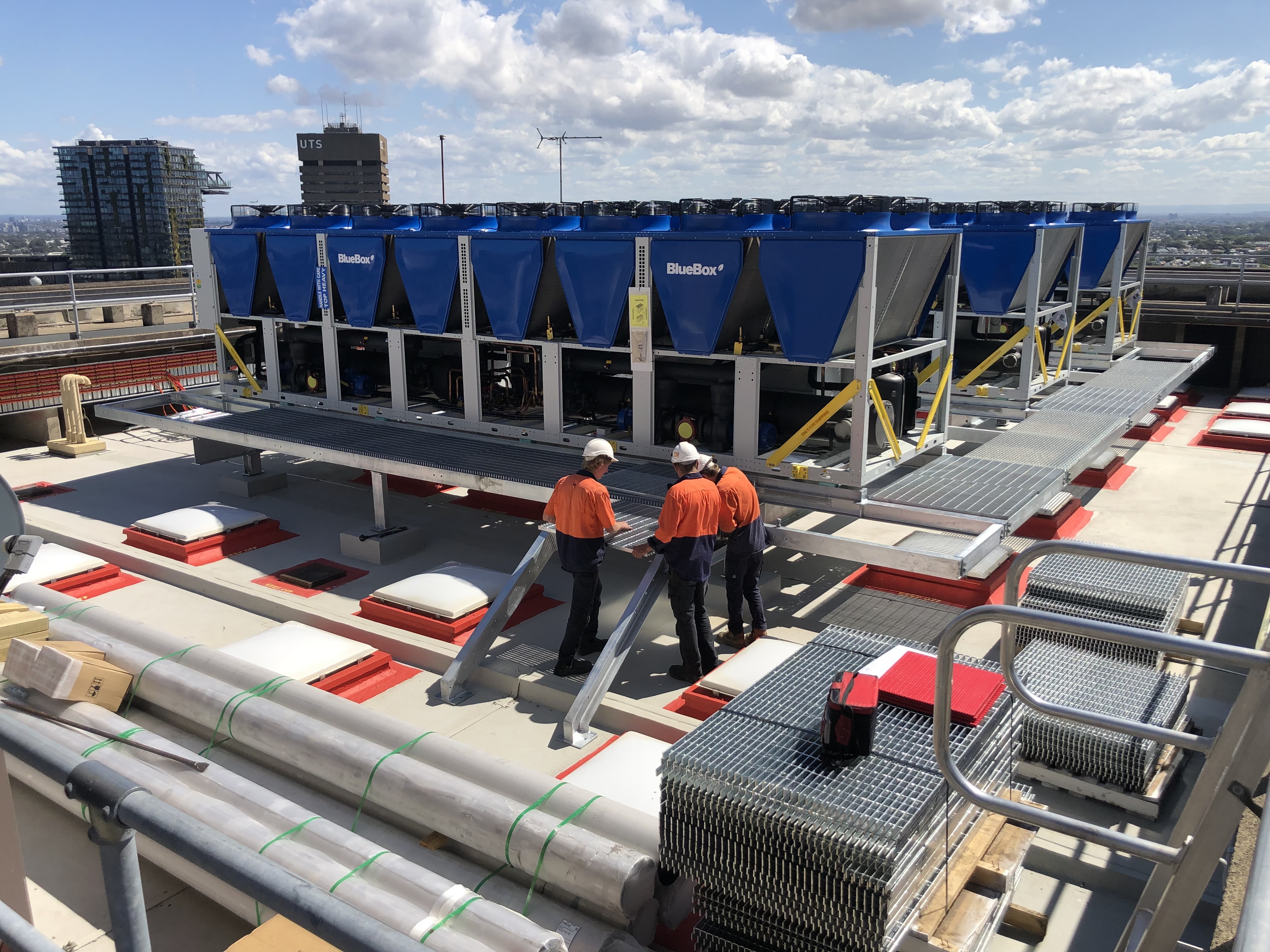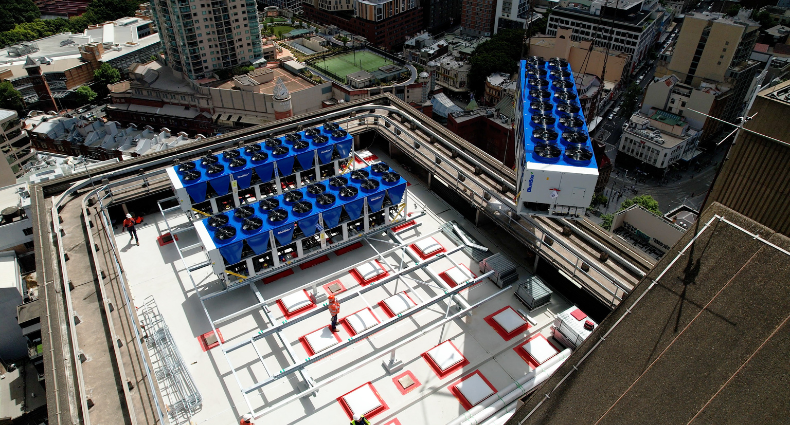Cromwell Property Group’s McKell Building was the first Sydney CBD office tower to undergo full electrification. Overcoming complex engineering and logistical challenges, Cromwell has future-proofed the building and created a playbook for other owners making the switch from gas to clean electricity.
“The gas boilers were at their end of life , so we had a decision to make: replace like-for-like, or take the opportunity to electrify. We knew the smarter, future-focused choice was electrification.”
Plugged into net zero policy
Cromwell Property Group acquired the 1979 asset in 2013 and has maintained a strong sustainability partnership through a green lease and ongoing upgrades.
But policy is moving fast. “We knew government tenants would soon be demanding all-electric, net zero-ready space,” says Cromwell’s National Manager of Property Sustainability, David Deller. “Electrifying early was a chance to future-proof the McKell Building, ensuring it remains competitive and adaptable in a rapidly evolving energy landscape.”
Fully occupied, the McKell Building is now directly aligned with the NSW Government’s Net Zero Government Operations Policy which requires government agencies with 100 or more staff to decarbonise their buildings and fleets.
Fast Facts:
- The McKell Building is a 24-storey, 25,000 sqm office tower in Sydney’s Haymarket, acquired by Cromwell in 2013.
- In 2024 it became the first multi-storey commercial building in the Sydney CBD to complete a full electrification upgrade.
- The building has improved its NABERS Energy rating from 2.5 to 5.5 stars since 2001, and now operates with zero reliance on fossil gas.
Switched on solutions
Before committing to electrification, Cromwell explored several technology pathways.
Replacing the old gas boilers with simple electric duct heaters was ruled out — too costly and disruptive. Standard heat pumps were considered, but they would have wasted large amounts of energy.
The solution chosen was a heat recovery chiller, which reuses “free energy” from the building’s heating and cooling. This option delivered the best balance of efficiency, cost and tenant continuity.
There was a risk that switching from gas to electricity could make the building look less efficient in the short term and drag down its NABERS rating. “We modelled the NABERS impact and could see that McKell would hold its 5.5 star rating post-electrification. That gave us the confidence to move forward knowing the building’s performance would be resilient.”
Why electrify?
Australia’s push to decarbonise buildings is accelerating from both ends: policy and market. Federal and state governments have set ambitious emissions reduction targets, backed by practical policies like the federal government’s Net Zero in Government Operations roadmap.
The Property Council of Australia and Green Building Council of Australia champion electrification through the Every Building Counts agenda. By 2026 only fully electric new buildings will be eligible for Green Star Buildings ratings.
NABERS is ratcheting up its benchmarks, retiring the use of GreenPower in energy ratings and tightening the treatment of gas. The NABERS Renewable Energy Indicator discloses the proportion of renewables versus fossil fuels on every NABERS certificate.
At the same time, market forces are pointing the same way. JLL research has found nearly three-quarters of large Sydney occupiers and two-thirds of Melbourne tenants already have net zero targets, yet there are “very few” fully electric offices available or in the pipeline. Electrified buildings with 5.5-star NABERS Energy ratings command a 10% rent premium and lower vacancy, JLL found.
For building owners, the conclusion is clear: the cost of electrification today is outweighed by the rising risks of stranded assets, tenant flight and escalating compliance costs tomorrow.
Testing the limits
Replacing McKell’s ageing gas boilers was far from a simple swap. The project team faced a major constraint: the building’s existing electrical backbone had limited spare capacity. Main switch room upgrades and new cabling would have added more hundreds of thousands of dollars to the budget.
The solution was to integrate automatic transfer switching into the design. This allows available power to be reallocated between the cooling plant and the new heat recovery chiller (HRC) as required. In peak summer, supply is directed to the chillers to maintain cooling. In winter, power is transferred to the HRC to deliver heating. During the shoulder season, the HRC provides both heating and cooling, balancing loads within the available supply.
Because the transfer switching is part of the permanent design, the system had to be carefully engineered so that critical building services never lost power. Any prolonged outage could have disrupted building operations. Working closely with equipment manufacturers, the project team validated the control logic and operating parameters to ensure long-term reliability.
David Deller compares the transfer of power to a heart transplant: “You can’t stop the patient’s vital organs while replacing the heart. The equipment must be kept alive even though the main power source has been removed.”
By re-using and reallocating existing cabling and connections, some dating back to the original building infrastructure, Cromwell avoided the need for a costly full electrical upgrade while still achieving a resilient, future-ready solution.

Lessons learnt
For David Deller, the McKell experience can be distilled into five practical lessons that can guide other owners on the path to electrification.
- Start early: End-of-life equipment is the ideal trigger, but design work needs to begin 12-24 months in advance to plan for space, structure and capacity.
- Reuse where you can: Careful testing and reallocation of existing equipment can reduce the cost of new infrastructure and minimise disruption.
- Keep the building alive: Designing alternative power transfer switching pathways at the McKell Building allowed power to be shifted without compromising essential operations. Success depended on close collaboration with subject matter experts.
- Let the data lead: Historical building management system data gave the team evidence to make confident choices, prove efficiency gains and challenge design assumptions.
- Work with the experts: Electrification is complex and can be expensive. Partnering closely with SMEs, contractors and manufacturers problem-solved in real time and brought deep technical knowledge to the table.
“We faced the same challenges other owners will: ageing infrastructure, limited space and live tenants,” David says. “What we’ve shown is that with the right planning, data and expertise, you can overcome those hurdles and create a building that is efficient, resilient and future-ready.”

